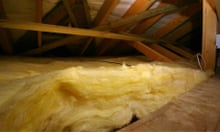Looking around it's hard to find clues. There are few obvious clues that Penney Poyzer and Gil Schalom live in one of the most radical homes in the UK. In the kitchen is a recently plastered wall; on the floor an organic veg box; and upstairs a dual-flush loo. Otherwise it's hard to find evidence that the couple have taken the sort of eco-nightmare draughty Victorian house lived in by millions of people in the UK and turned it into an almost totally carbon-free home, with a gas bill of £20 a year.
The house, in a suburb of Nottingham, is part of Old Home SuperHome, a growing network of eco-showhomes, aimed at persuading people to transform their homes into ecofriendly buildings. Organisers hope that people can be encouraged to snoop around these showhomes, learn about energy- efficiency and the various technologies that can generate zero or low carbon heat and electricity, and be inspired to adopt them themselves.
Today the Department of Energy and Climate Change willannounce financial help to persuade seven million homeowners to give their house or flat an eco-makeover, and so cut fuel bills and reduce global warming emissions, more than a quarter of which come from the energy used by households. However, if they cannot "see and touch" the experience, most will be reluctant to try it, says John Doggart, chairman of the charity Sustainable Energy Academy, which is organising the Old Home SuperHome project.
The theory is based on what psychologists called "salience", which some environmental thinkers argue needs to be the basis of a major shift in campaigning – from telling people what to do, to showing them how life can be different. "Salience is one of the deepest, most basic of buttons that can be pushed and the reason is because those things we can imagine in our heads, we believe – and those things we can't see pictures of, we don't believe. It's one of the reasons we believe in fairies, but find it hard to believe in quantum physics," says Solitaire Townsend of sustainable communications company Futerra.
The SuperHome network already has nearly 30 members in 12 locations, and there are plans for up to 300 in five years' time. Visitors this year will reach 35-40,000, and it is hoped that number will rise to 200,000 by 2014. Eventually, Doggart wants to see a SuperHome within 15 minutes of nearly every person in the country, up to 1,000 in total – "one for every Tescos".
To join the network, homeowners must reduce emissions by at least 50-60%, depending on the property, according to a computer model which works on average use of energy for a property of the size and design, to iron out differences in occupants' behaviour. They have to admit the public at least one day a year. The SEA pays £70 a session for the "hassle factor", funds information leaflets and runs the website with information and contact details for each home. It will soon add a My Green Builder page where members recommend suppliers.
Poyzer, a writer and broadcaster, and Schalom, an architect, are extreme: they spent 10 years and £30,000 on energy improvements alone. By using insulation up to a foot thick and draught-strips on windows, doors, skirtings and floorboards, installing a wood-fired boiler and even changing to a smaller bath, they cut their modelled carbon dioxide emissions from 19 tonnes a year to half a tonne, and reduced their annual energy bills by between £2,000 and £3,000.
This leaky Nottingham home was a particularly tricky one to fix. Average Superhome owners spend £15-20,000, and should recoup this in lower bills within 10-15 years if fuel prices do not rise. Evidence from Australia suggests prices for more efficient homes will rise, says Doggart. Some costs have also fallen and more help is becoming available.
But, says Poyzer: "All the stuff we're learning has to come from the worst case scenario."
Find out more about the SuperHomes network
Things you can do:
Energy experts stress that, ultimately, homes need to be completely insulated and fitted with energy-saving devices but, in the meantime, here are a few simple things that can be done in a weekend:
Change to low-energy lightbulbs.
Plug computer equipment into a Bye Bye Standby, which turns it off after a set time.
Swap to a programmable thermostat that can give you different temperatures throughout the day.
Draught-proof windows and doors.
Put a Sava-flush (often supplied free by water companies) into the loo cistern to reduce water used when flushing.
Cable grommets (available online) can be fitted over the hole of a light flex in the ceiling to reduce draughts.
Seal the tops and bottoms of skirting boards using silicon mastic or decorative caulking.
Insulate any draughty gaps between wooden floorboards.
Put reflective panels behind radiators.
For more information, visit the National Energy Foundation or bre.co.uk


